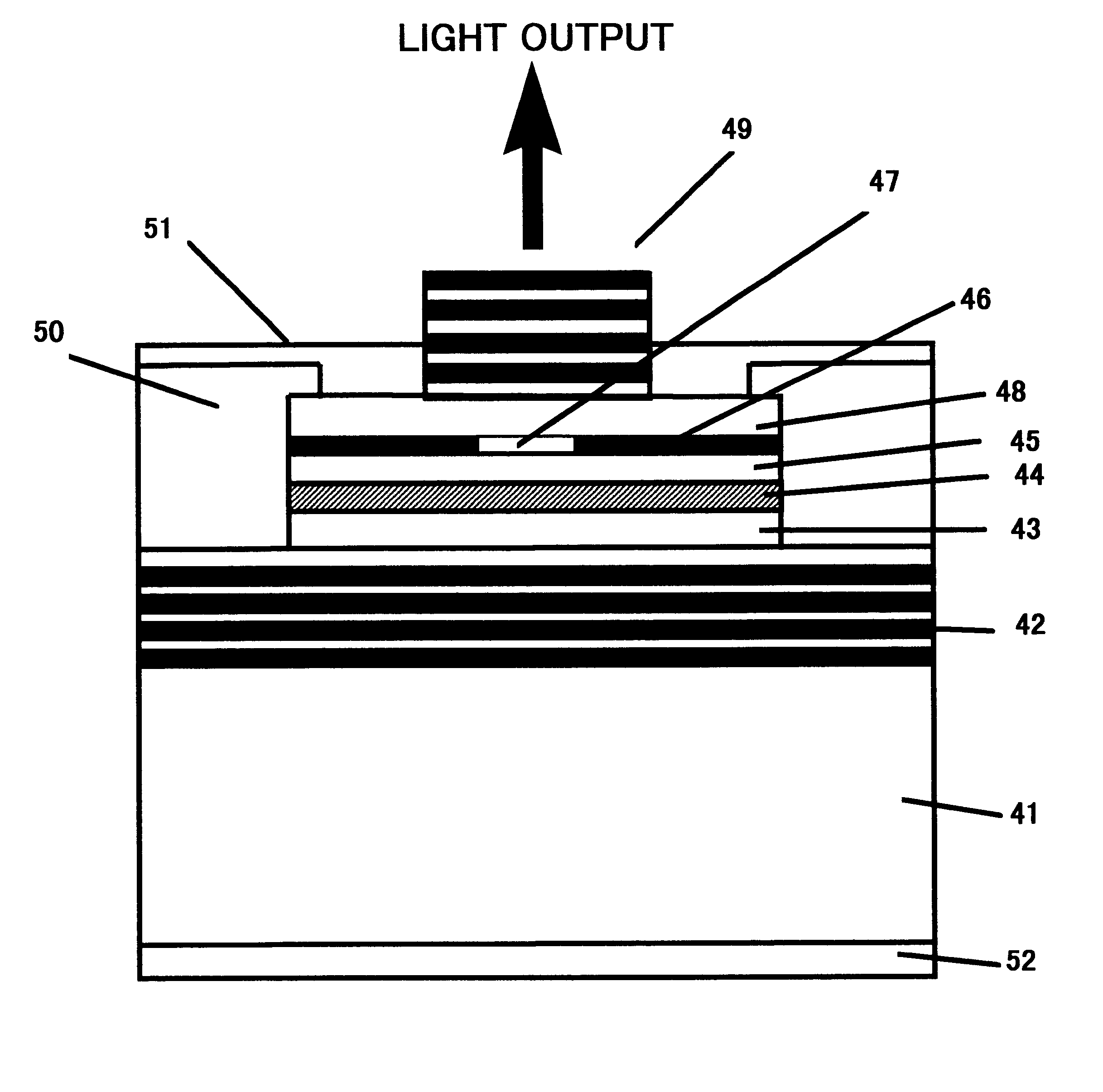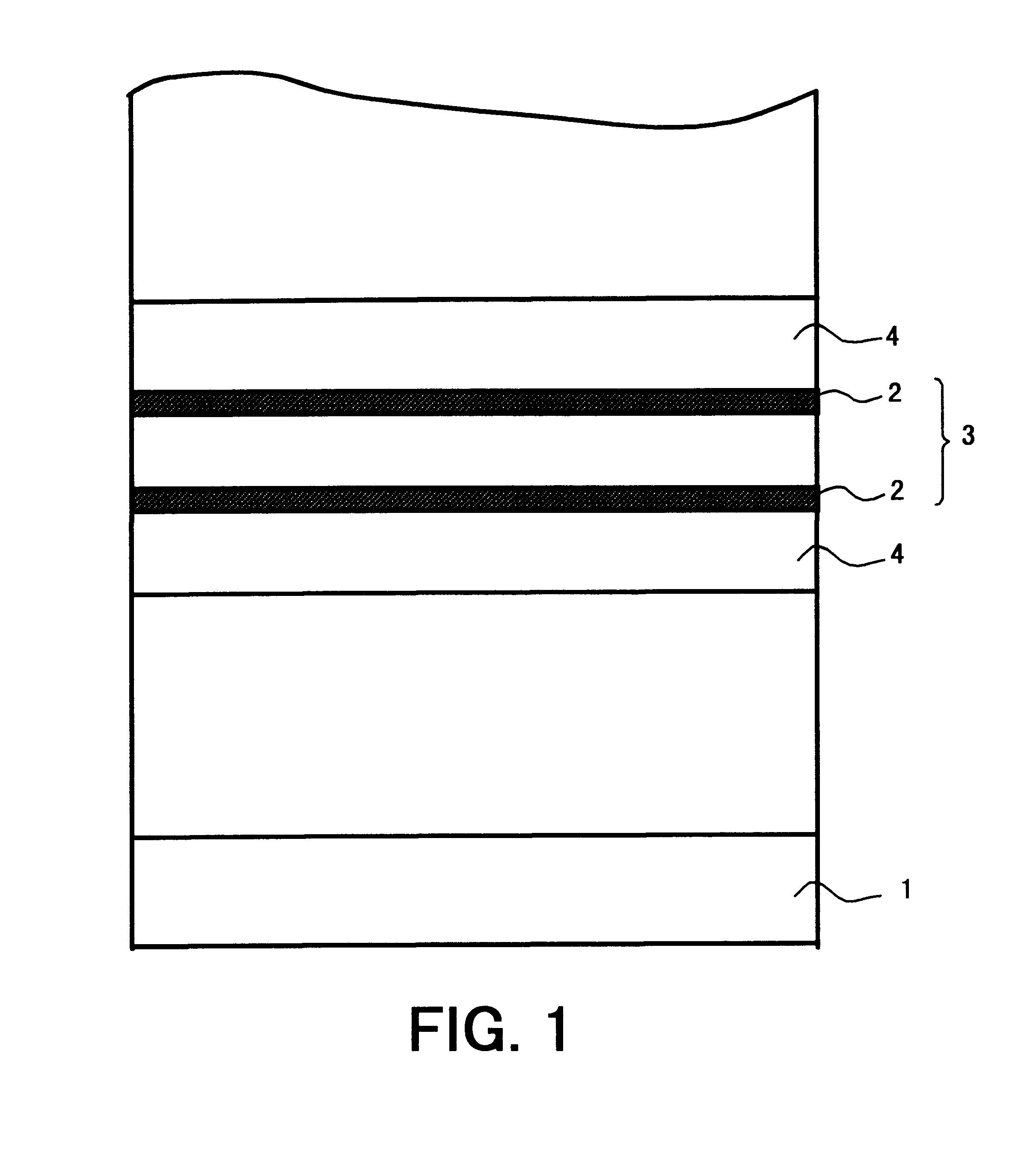Light emitting devices with layered III-V semiconductor structures
- Summary
- Abstract
- Description
- Claims
- Application Information
AI Technical Summary
Benefits of technology
Problems solved by technology
Method used
Image
Examples
example 1
A light emitting device according to the present invention was fabricated as illustrated in FIG. 8. The device was a dielectric-stripe laser incorporating an SCH-DQW (separate confinement heterostructure double quantum well) layer structure.
Referring to FIG. 8, the light emitting device was formed on a (100) n-GaAs substrate 21 with the following layers grown contiguously thereon, in the order recited:
an n-GaAs buffer layer 22,
an n-GaInP(As) lower cladding layer 23 having a thickness of 1.5 micron,
a GaAs light guide layer 24 having a thickness of 100 nm, an active (i.e., light emitting) region 27, having a thickness of 13 nm and including Ga.sub.1-x In.sub.x As quantum well layers 25a, 25b and a GaAs barrier layer 26 interposed therebetween;
a GaAs light guide layer 28 having a thickness of 100 nm,
a p-GaInP(As) upper cladding layer 29 having a thickness of 1.5 micron, and
a p-GaAs contact layer 30 having a thickness of 0.3 micron.
Subsequently, the p-GaAs contact layer 30 was subjected...
example 2
A further light emitting device according to the present invention was fabricated in a manner similar to Example 1, with the exception that the active region included Ga.sub.0.67 In.sub.0.33 N.sub.0.006 As.sub.0.994 quantum well layers and GaAs barrier layers, in place of the Ga.sub.-x In.sub.x As quantum well layers and GaAs barrier layer of Example 1.
The device was a dielectric-stripe laser incorporating an SCH-DQW layer structure.
Now referring again to FIG. 8, the light emitting device was formed on a (100) n-GaAs substrate with the following layers grown contiguously thereon, in the order recited:
an n-GaAs buffer layer,
an n-GaInP(As) lower cladding layer having a thickness of 1.5 micron,
a GaAs light guide layer having a thickness of 100 nm,
an active region including Ga.sub.0.67 In.sub.0.33 N.sub.0.006 As.sub.0.994 quantum well layers and GaAs barrier layers each having a thickness of 13 nm and interposed therebetween, which were formed in similar manner to those illustrated in F...
example 3
A light emitting device according to the present invention was fabricated in a manner similar to Example 2, with the exception that an n-GaAs substrate was used such that the direction normal to the surface thereof was misoriented by approximately 2.degree. from the direction normal to the (100) plane toward the [011] direction, and that the active region comprised Ga.sub.0.6 In.sub.0.4 N.sub.0.005 As.sub.0.995 quantum well layers.
The device was a dielectric-stripe laser incorporating an SCH-DQW layer structure.
Referring again to FIG. 8, the light emitting device was formed on the above-mentioned n-GaAs substrate with the following layers grown contiguously thereon, in the order recited:
an n-GaAs buffer layer,
a n-GaInP(As) lower cladding layer having a thickness of 1.5 micron,
a GaAs light guide layer having a thickness of 100 nm,
an active region including Ga.sub.0.6 In.sub.0.4 N.sub.0.005 As.sub.0.995 quantum well layers and GaAs barrier layers each having a thickness of 13 nm and i...
PUM
 Login to View More
Login to View More Abstract
Description
Claims
Application Information
 Login to View More
Login to View More - R&D
- Intellectual Property
- Life Sciences
- Materials
- Tech Scout
- Unparalleled Data Quality
- Higher Quality Content
- 60% Fewer Hallucinations
Browse by: Latest US Patents, China's latest patents, Technical Efficacy Thesaurus, Application Domain, Technology Topic, Popular Technical Reports.
© 2025 PatSnap. All rights reserved.Legal|Privacy policy|Modern Slavery Act Transparency Statement|Sitemap|About US| Contact US: help@patsnap.com



